Fast DOA Estimation Algorithms via Positive Incremental Modified Cholesky Decomposition for Augmented Coprime Array Sensors
Abstract
1. Introduction
2. Signal Model
2.1. Array Structure
2.2. Signal Reception Model
3. PI-MCANM-Based DOA Estimation Algorithm
3.1. Virtual Array Interpolation
3.2. Atomic Norm Minimization
3.3. Fast DOA Estimation via Positive Incremental Modified Cholesky Decomposition
| Algorithm 1 Positive incremental modified Cholesky decomposition-based DOA estimation. |
|
4. Simulation Results
4.1. Degrees of Freedom Analysis
4.2. Resolution Analysis
4.3. Estimation Accuracy Analysis
4.4. Computational Complexity Analysis
5. Conclusions
Author Contributions
Funding
Institutional Review Board Statement
Informed Consent Statement
Data Availability Statement
Conflicts of Interest
References
- Yang, J.; Liao, G.; Li, J. An Efficient Off-Grid DOA Estimation Approach for Nested Array Signal Processing by Using Sparse Bayesian Learning Strategies. Signal Process. 2016, 128, 110–122. [Google Scholar] [CrossRef]
- Yang, Z.; Xie, L.; Zhang, C. A Discretization-Free Sparse and Parametric Approach for Linear Array Signal Processing. IEEE Trans. Signal Process. 2014, 62, 4959–4973. [Google Scholar] [CrossRef]
- Fernández-Menduiña, S.; Krahmer, F.; Leus, G.; Bhandari, A. Computational Array Signal Processing via Modulo Non-Linearities. IEEE Trans. Signal Process. 2022, 70, 2168–2179. [Google Scholar] [CrossRef]
- Zhang, Z.; Zhou, C.; Gu, Y.; Zhou, J.; Shi, Z. An IDFT Approach for Coprime Array Direction-of-Arrival Estimation. Digit. Signal Process. 2019, 94, 45–55. [Google Scholar] [CrossRef]
- Vallet, P.; Mestre, X.; Loubaton, P. Performance Analysis of an Improved MUSIC DoA Estimator. IEEE Trans. Signal Process. 2015, 63, 6407–6422. [Google Scholar] [CrossRef]
- Wang, R.; Wang, Y.; Li, Y.; Cao, W.; Yan, Y. Geometric algebra-based ESPRIT algorithm for DOA estimation. Sensors 2021, 21, 5933. [Google Scholar] [CrossRef]
- Lavate, T.; Kokate, V.; Sapkal, A. Performance Analysis of MUSIC and ESPRIT DOA Estimation Algorithms for Adaptive Array Smart Antenna in Mobile Communication. In Proceedings of the 2010 Second International Conference on Computer and Network Technology, Bangkok, Thailand, 23–25 April 2010; pp. 308–311. [Google Scholar] [CrossRef]
- Zoubir, A.M.; Koivunen, V.; Chakhchoukh, Y.; Muma, M. Robust Estimation in Signal Processing: A Tutorial-Style Treatment of Fundamental Concepts. IEEE Signal Process. Mag. 2012, 29, 61–80. [Google Scholar] [CrossRef]
- Shen, Q.; Liu, W.; Cui, W.; Wu, S. Underdetermined DOA Estimation Under the Compressive Sensing Framework: A Review. IEEE Access 2016, 4, 8865–8878. [Google Scholar] [CrossRef]
- Fortunati, S.; Grasso, R.; Gini, F.; Greco, M.S.; LePage, K. Single-snapshot DOA estimation by using compressed sensing. EURASIP J. Adv. Signal Process. 2014, 2014, 1–17. [Google Scholar] [CrossRef]
- Vaidyanathan, P.P.; Pal, P. Sparse sensing with co-prime samplers and arrays. IEEE Trans. Signal Process. 2010, 59, 573–586. [Google Scholar] [CrossRef]
- Vaidyanathan, P.; Pal, P. Direct-MUSIC on sparse arrays. In Proceedings of the 2012 International Conference on Signal Processing and Communications (SPCOM), Bangalore, India, 11–15 July 2012; pp. 1–5. [Google Scholar]
- Pal, P.; Vaidyanathan, P.P. Coprime sampling and the MUSIC algorithm. In Proceedings of the 2011 Digital Signal Processing and Signal Processing Education Meeting (DSP/SPE), Sedona, AZ, USA, 4–7 January 2011; pp. 289–294. [Google Scholar]
- Xu, H.; Wang, D.; Ba, B.; Cui, W.; Zhang, Y. Direction-of-Arrival Estimation for Both Uncorrelated and Coherent Signals in Coprime Array. IEEE Access 2019, 7, 18590–18600. [Google Scholar] [CrossRef]
- Liu, K.; Zhang, Y.D. Coprime Array-Based DOA Estimation in Unknown Nonuniform Noise Environment. Digit. Signal Process. 2018, 79, 66–74. [Google Scholar] [CrossRef]
- Zhang, Y.D.; Amin, M.G.; Himed, B. Sparsity-Based DOA Estimation Using Co-Prime Arrays. In Proceedings of the 2013 IEEE International Conference on Acoustics, Speech and Signal Processing, Vancouver, BC, Canada, 26–31 May 2013; pp. 3967–3971. [Google Scholar] [CrossRef]
- Gemba, K.L.; Nannuru, S.; Gerstoft, P. Robust Ocean Acoustic Localization With Sparse Bayesian Learning. IEEE J. Sel. Top. Signal Process. 2019, 13, 49–60. [Google Scholar] [CrossRef]
- Zheng, W.; Zhang, X.; Wang, Y.; Shen, J.; Champagne, B. Padded Coprime Arrays for Improved DOA Estimation: Exploiting Hole Representation and Filling Strategies. IEEE Trans. Signal Process. 2020, 68, 4597–4611. [Google Scholar] [CrossRef]
- Shi, Z.; Zhou, C.; Gu, Y.; Goodman, N.A.; Qu, F. Source Estimation Using Coprime Array: A Sparse Reconstruction Perspective. IEEE Sens. J. 2017, 17, 755–765. [Google Scholar] [CrossRef]
- Wang, M.; Nehorai, A. Coarrays, MUSIC, and the Cramér–Rao Bound. IEEE Trans. Signal Process. 2017, 65, 933–946. [Google Scholar] [CrossRef]
- Liu, C.L.; Vaidyanathan, P.P.; Pal, P. Coprime Coarray Interpolation for DOA Estimation via Nuclear Norm Minimization. In Proceedings of the 2016 IEEE International Symposium on Circuits and Systems (ISCAS), Montreal, QC, Canada, 22–25 May 2016; pp. 2639–2642. [Google Scholar] [CrossRef]
- Zhou, C.; Shi, Z.; Gu, Y.; Goodman, N.A. Doa Estimation by Covariance Matrix Sparse Reconstruction of Coprime Array. In Proceedings of the 2015 IEEE International Conference on Acoustics, Speech and Signal Processing (ICASSP), South Brisbane, QLD, Australia, 19–24 April 2015; pp. 2369–2373. [Google Scholar] [CrossRef]
- Wu, X.; Zhu, W.P.; Yan, J. A Toeplitz Covariance Matrix Reconstruction Approach for Direction-of-Arrival Estimation. IEEE Trans. Veh. Technol. 2017, 66, 8223–8237. [Google Scholar] [CrossRef]
- Zheng, Z.; Huang, Y.; Wang, W.Q.; So, H.C. Augmented Covariance Matrix Reconstruction for DOA Estimation Using Difference Coarray. IEEE Trans. Signal Process. 2021, 69, 5345–5358. [Google Scholar] [CrossRef]
- Barthelme, A.; Utschick, W. DoA Estimation Using Neural Network-Based Covariance Matrix Reconstruction. IEEE Signal Process. Lett. 2021, 28, 783–787. [Google Scholar] [CrossRef]
- Zhou, C.; Gu, Y.; Shi, Z.; Haardt, M. Structured Nyquist Correlation Reconstruction for DOA Estimation with Sparse Arrays. IEEE Trans. Signal Process. 2023, 71, 1849–1862. [Google Scholar] [CrossRef]
- Li, S.; Yang, D.; Tang, G.; Wakin, M.B. Atomic Norm Minimization for Modal Analysis From Random and Compressed Samples. IEEE Trans. Signal Process. 2018, 66, 1817–1831. [Google Scholar] [CrossRef]
- Zhou, C.; Gu, Y.; Fan, X.; Shi, Z.; Mao, G.; Zhang, Y.D. Direction-of-Arrival Estimation for Coprime Array via Virtual Array Interpolation. IEEE Trans. Signal Process. 2018, 66, 5956–5971. [Google Scholar] [CrossRef]
- Lau, K.H.; Ng, C.K.; Song, J. Low-Complex Single-Snapshot DoA-Estimation With Higher Degree of Atomic Separation-Freedom in a MU-MIMO System Aided by Prior Information. IEEE Signal Process. Lett. 2023, 30, 349–353. [Google Scholar] [CrossRef]
- Wang, Y.; Tian, Z. IVDST: A Fast Algorithm for Atomic Norm Minimization in Line Spectral Estimation. IEEE Signal Process. Lett. 2018, 25, 1715–1719. [Google Scholar] [CrossRef]
- Ma, T.; Fan, X.; Wu, X. A Fast Gridless mmWave Full-Dimensional MIMO Channel Estimation Method. Digit. Signal Process. 2022, 129, 103627. [Google Scholar] [CrossRef]
- Wang, X.; Wang, X. Hole Identification and Filling in K-Times Extended Co-Prime Arrays for Highly Efficient DOA Estimation. IEEE Trans. Signal Process. 2019, 67, 2693–2706. [Google Scholar] [CrossRef]
- Wang, X.; Chen, Z.; Ren, S.; Cao, S. DOA Estimation Based on the Difference and Sum Coarray for Coprime Arrays. Digit. Signal Process. 2017, 69, 22–31. [Google Scholar] [CrossRef]
- Fang, H.R.; O’leary, D.P. Modified Cholesky algorithms: A catalog with new approaches. Math. Program. 2008, 115, 319–349. [Google Scholar] [CrossRef][Green Version]
- Grant, M.; Boyd, S. CVX: Matlab Software for Disciplined Convex Programming, Version 2.1. 2014. Available online: http://cvxr.com/cvx (accessed on 5 March 2023).
- Thakre, A.; Haardt, M.; Giridhar, K. Single Snapshot Spatial Smoothing With Improved Effective Array Aperture. IEEE Signal Process. Lett. 2009, 16, 505–508. [Google Scholar] [CrossRef]
- Stoica, P.; Nehorai, A. MUSIC, Maximum Likelihood, and Cramer-Rao Bound. IEEE Trans. Acoust. Speech, Signal Process. 1989, 37, 720–741. [Google Scholar] [CrossRef]
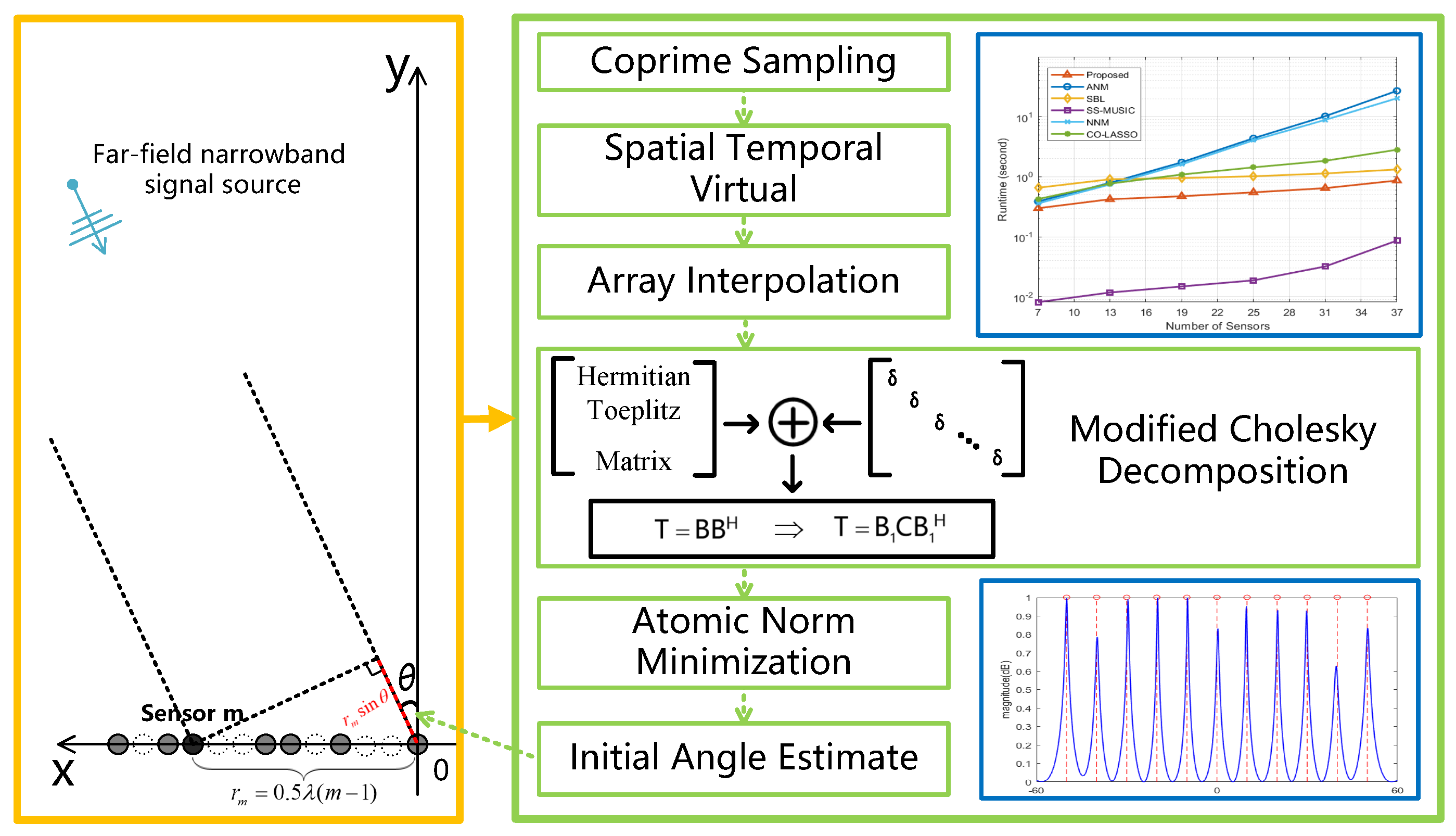
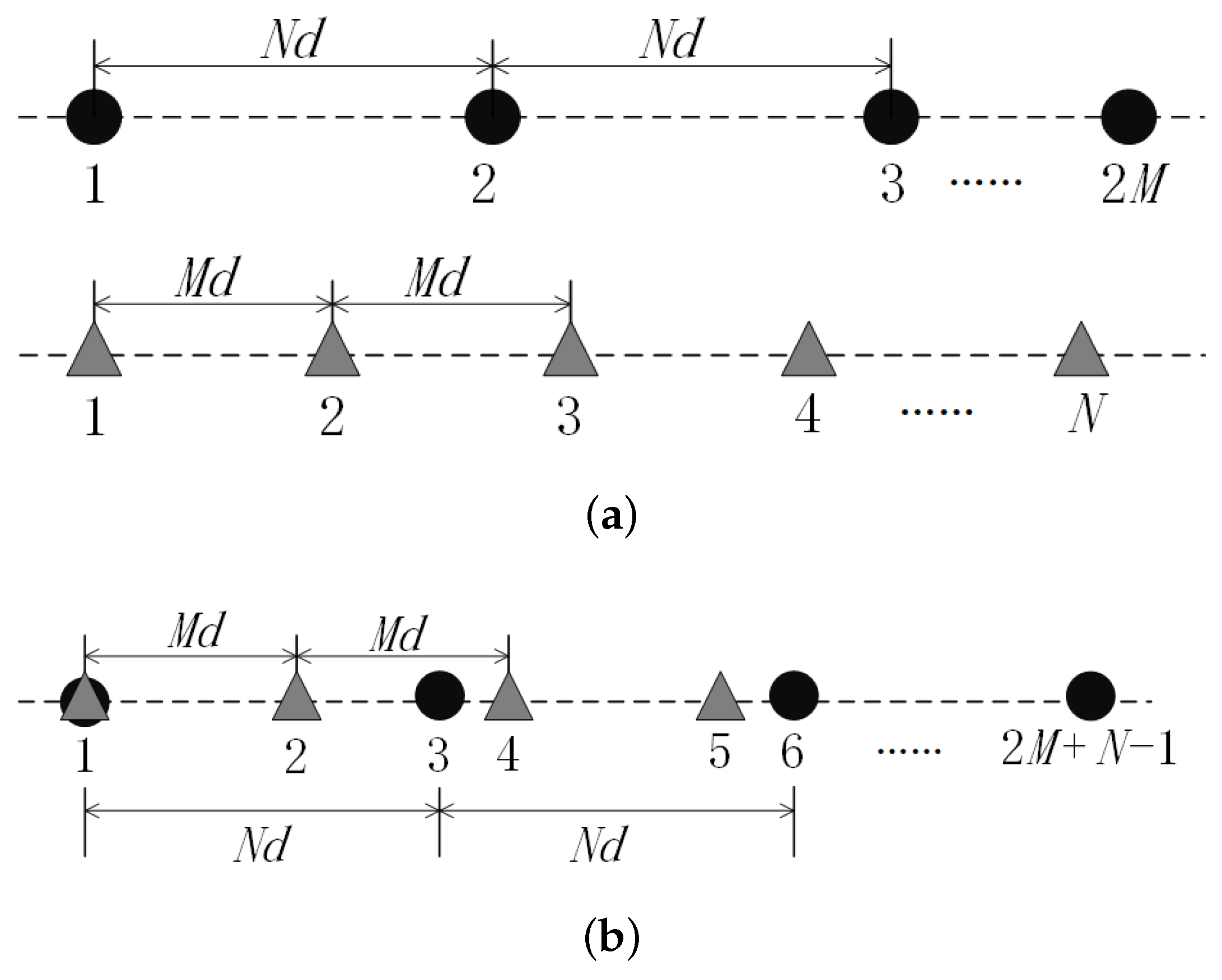
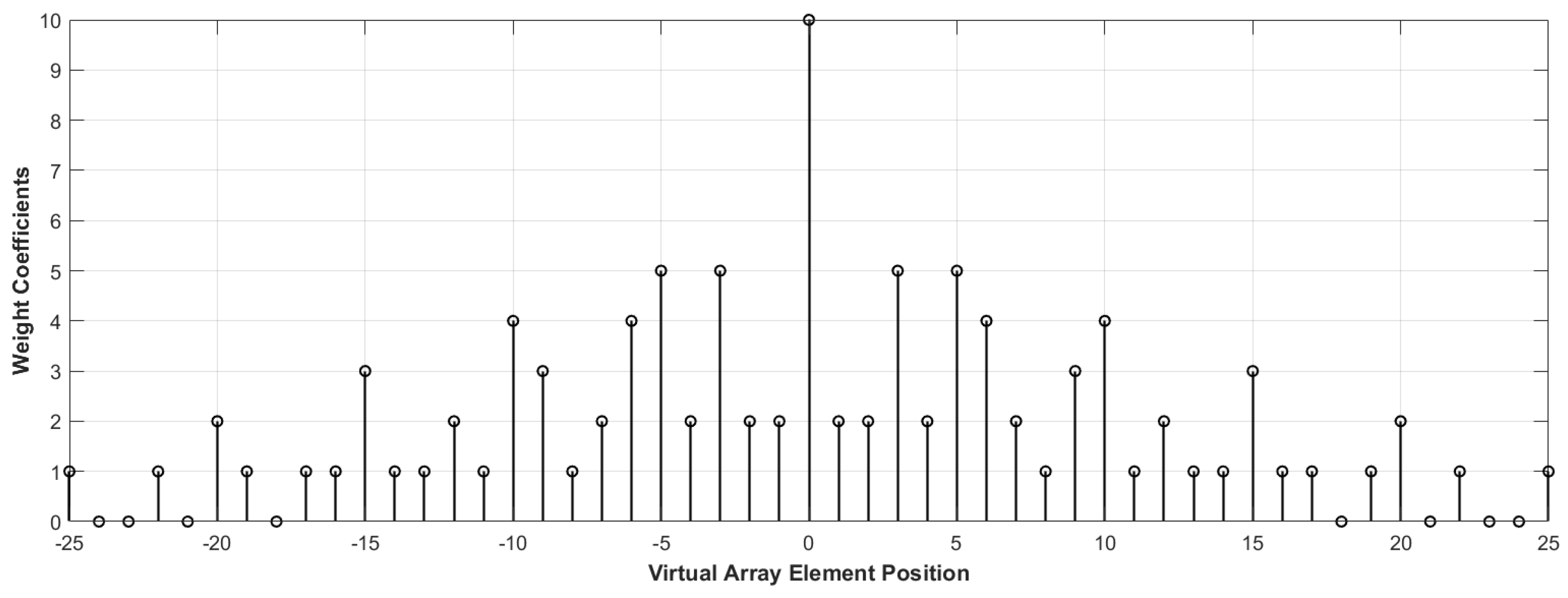

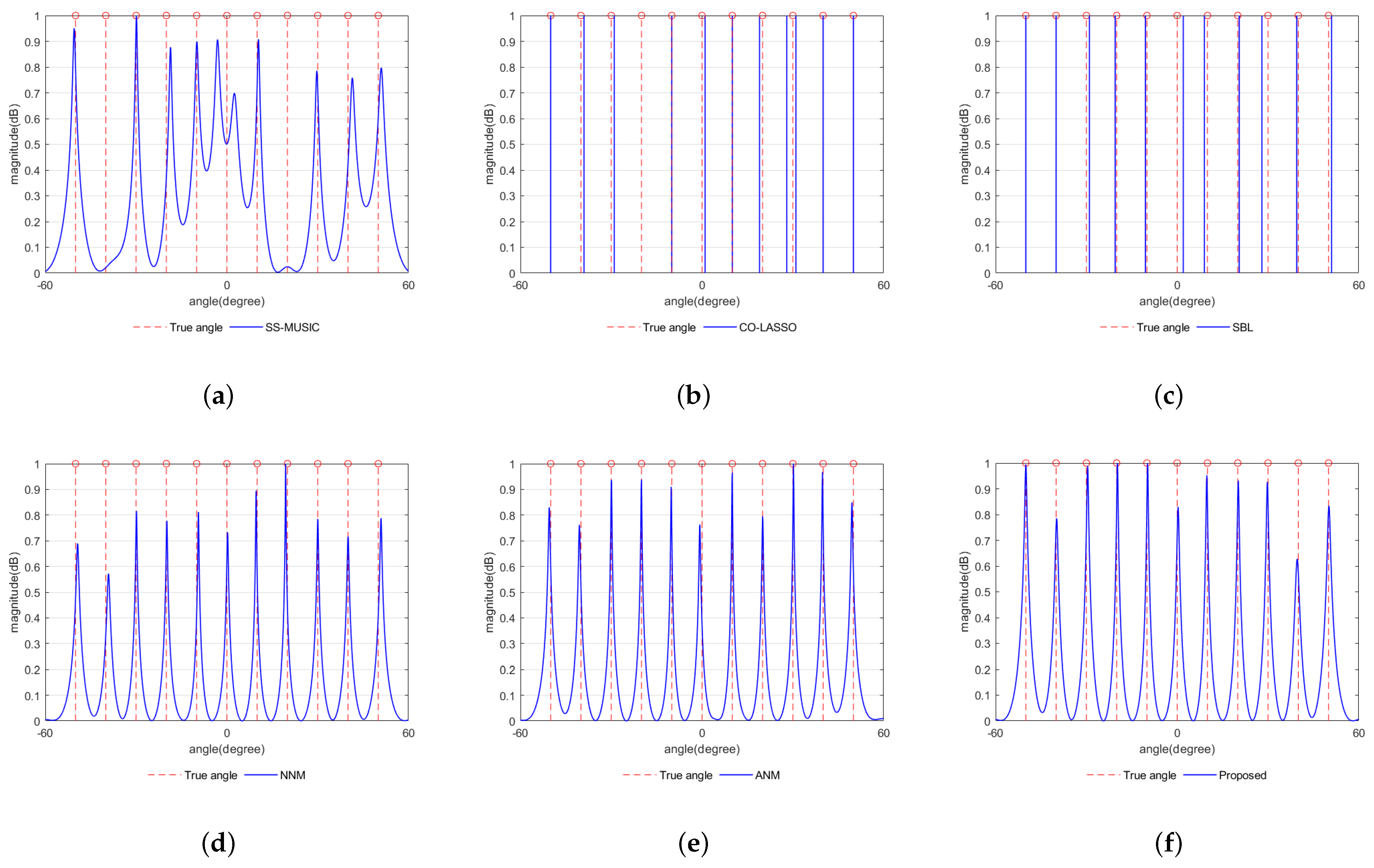

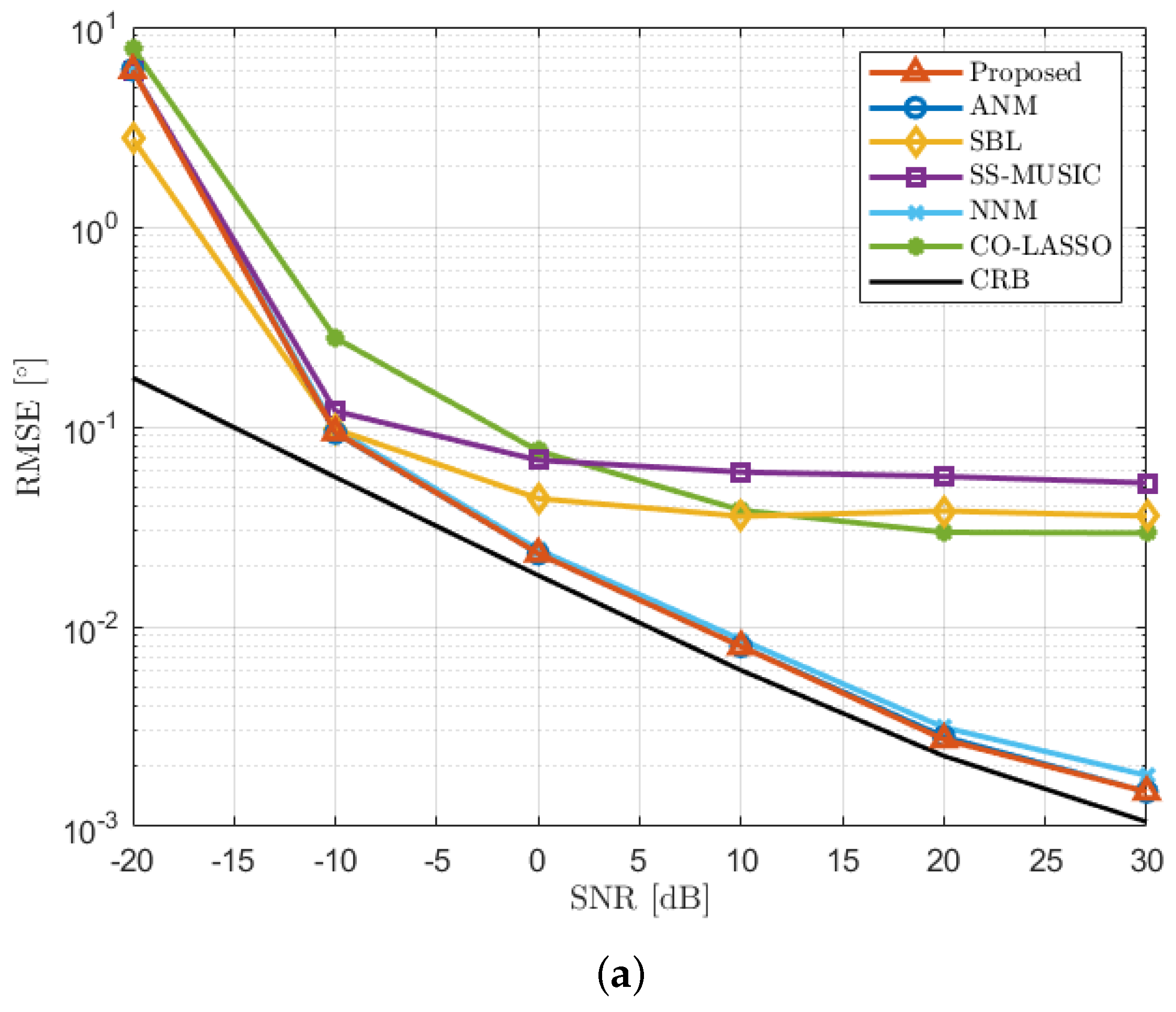
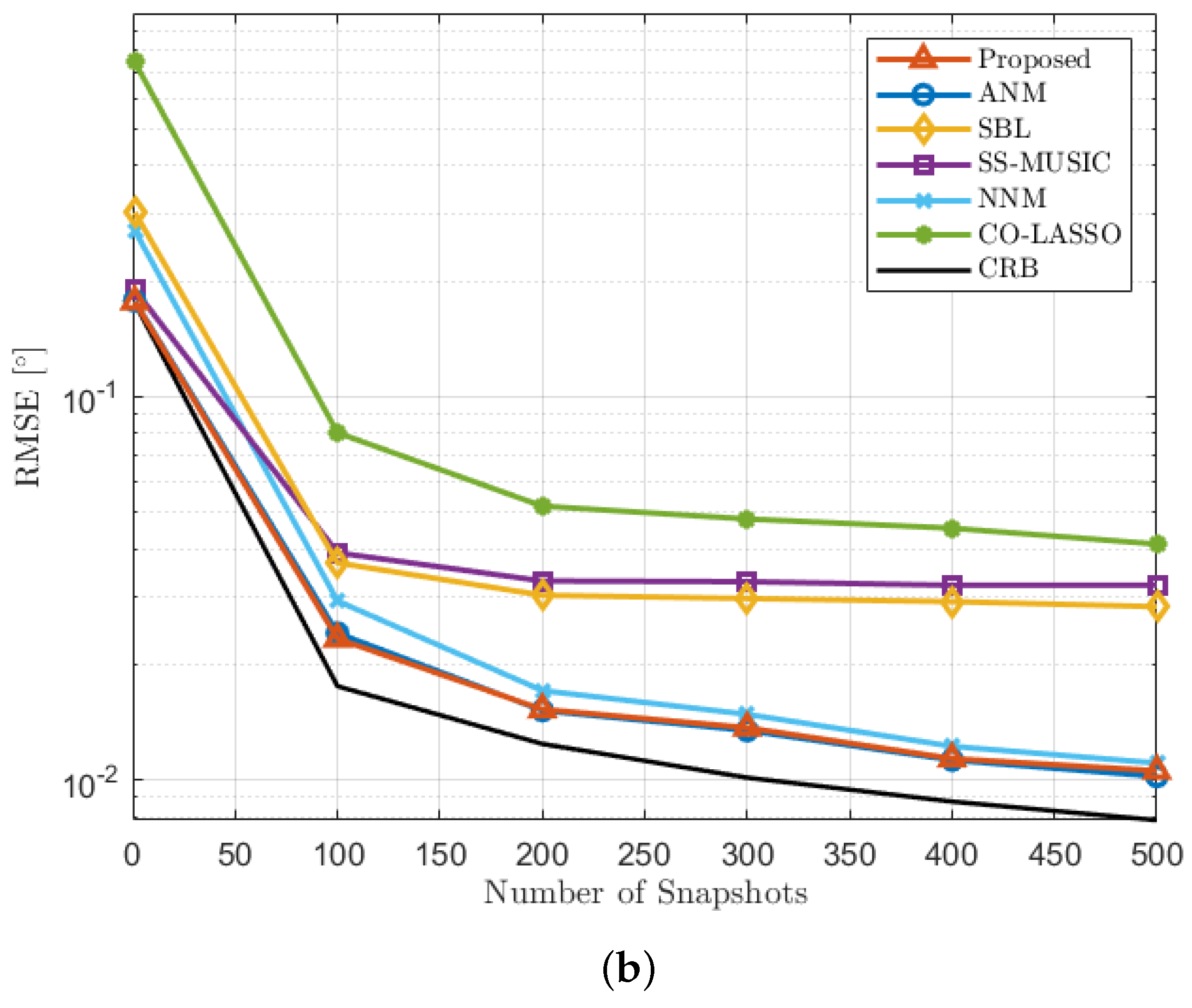

Disclaimer/Publisher’s Note: The statements, opinions and data contained in all publications are solely those of the individual author(s) and contributor(s) and not of MDPI and/or the editor(s). MDPI and/or the editor(s) disclaim responsibility for any injury to people or property resulting from any ideas, methods, instructions or products referred to in the content. |
© 2023 by the authors. Licensee MDPI, Basel, Switzerland. This article is an open access article distributed under the terms and conditions of the Creative Commons Attribution (CC BY) license (https://creativecommons.org/licenses/by/4.0/).
Share and Cite
Song, J.; Cao, L.; Zhao, Z.; Wang, D.; Fu, C. Fast DOA Estimation Algorithms via Positive Incremental Modified Cholesky Decomposition for Augmented Coprime Array Sensors. Sensors 2023, 23, 8990. https://doi.org/10.3390/s23218990
Song J, Cao L, Zhao Z, Wang D, Fu C. Fast DOA Estimation Algorithms via Positive Incremental Modified Cholesky Decomposition for Augmented Coprime Array Sensors. Sensors. 2023; 23(21):8990. https://doi.org/10.3390/s23218990
Chicago/Turabian StyleSong, Jing, Lin Cao, Zongmin Zhao, Dongfeng Wang, and Chong Fu. 2023. "Fast DOA Estimation Algorithms via Positive Incremental Modified Cholesky Decomposition for Augmented Coprime Array Sensors" Sensors 23, no. 21: 8990. https://doi.org/10.3390/s23218990
APA StyleSong, J., Cao, L., Zhao, Z., Wang, D., & Fu, C. (2023). Fast DOA Estimation Algorithms via Positive Incremental Modified Cholesky Decomposition for Augmented Coprime Array Sensors. Sensors, 23(21), 8990. https://doi.org/10.3390/s23218990




